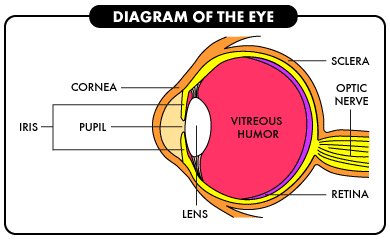 |
| Labeled Human Eye Diagram |
The human eye is the very important organ as it gives the sense of sight to see the world around us. It detects bright light or dim light but it cannot sense the object in the absence of light. What we see is called the light.
Light passes through the cornea, pupil and lens before hitting the retina.
PARTS OF THE EYE
The outer part called cornea is the clear bulging surface in front of the eye.
The sclera is the white part of the eye.
The iris is the colorful part of the eye. It decides the amount of light passes through the pupil and thus controls the size of the pupil.
The pupil is the black circle in the center of the iris. The pupils will get smaller when the light shines near them and they'll open wider when the light is gone.
The vitreous body is the biggest part of the eye and is also responsible for the shape of the eye.
The lens, an inner part of the eye lies behind the iris. It focuses light onto the retina and changes shape to make the fine adjustments needed to produce a sharp image. This is called accommodation. As we get older, accommodation becomes slower and weaker.
The retina lies in the back of the eye. It is made up of special cells called 'rods' and 'cones' .
Rods can 'see' black and white. Cones can 'see' colors. With both combined, we can see the whole picture.
The optic nerve is located in the back of the eye and it helps to connect the eye to the brain.
How the Eyes work?
When the image hits the retina, it changes the object upside down and convert them into an electrical message for the brain.
Then, the optic nerve carries those messages from the eye to the brain. Our each eye sees the object differently as two objects. Fortunately, our brain merges the objects which we see in our both eyes into one. The optic nerve serves as a messenger connecting the eye to the brain. Finally, our brain understands what we are seeing "cat," "apple," or "bicycle," or whatever the case may be.
All the parts of our eyes are extremely delicate. We should take good care of our eyes to protect our eyesight.
Comments